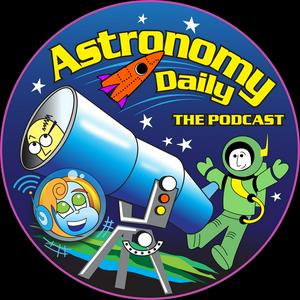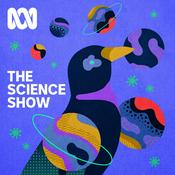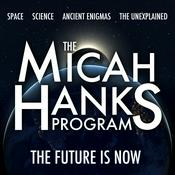701 episodes

From Lunar Power Plants to Wobbling Comets: Your Daily Space Update
24/12/2025 | 7 mins.
In this episode, we explore groundbreaking developments in lunar colonization and the intriguing behaviors of interstellar visitors. We kick off with a bold announcement from Russia, revealing plans to construct a nuclear power plant on the Moon in collaboration with China, aiming for completion by 2036. This ambitious project signifies a shift towards sustainable human presence on the lunar surface. Next, we dive into a sci-fi-inspired innovation as Russia's Energia rocket company patents a spacecraft design featuring artificial gravity, a game-changer for long-duration space missions, potentially mitigating the adverse effects of zero gravity on astronauts.Shifting gears, we celebrate a significant achievement in satellite technology with the launch of Bluebird 6, a record-breaking satellite designed to provide broadband internet directly to smartphones, boasting the largest communication array ever deployed in low Earth orbit. However, not all news is positive, as Japan faces a setback with the failure of its H3 rocket during a critical mission to deliver the Michibiki 5 satellite, crucial for enhancing GPS accuracy in East Asia.Finally, we journey beyond our solar system to investigate the interstellar comet 3I ATLAS, which exhibits unusual behavior, including a rare sun-facing anti-tail and wobbling jets of outgassing material. This discovery provides insights into the comet's rotation, revealing its nucleus spins once every 15.5 hours. Join us as we unpack these fascinating stories and more in this episode of Astronomy Daily!00:00 – **Today we're covering ambitious plans for lunar colonization and fascinating new discoveries00:36 – **Russia plans to build a nuclear power plant on the moon by 203601:49 – **Russian rocket company has just secured a patent for a new spacecraft design03:11 – **Indian rocket recently launched the Bluebird 6 satellite, and it's a record breaker04:27 – **Japan's ambitions for an independent satellite navigation system suffered a significant blow05:31 – **Astronomers studying interstellar comet 3I ATLAS have observed unusual behavior06:59 – **Today's featured news includes ambitious plans for nuclear power on the Moon### Sources & Further Reading1. NASA2. Roscosmos3. Space.com4. AST SpaceMobile5. JAXA### Follow & ContactX/Twitter: @AstroDailyPodInstagram: @astrodailypodEmail: [email protected]: astronomydaily.ioClear skies and see you next time! 🌟Become a supporter of this podcast: Support Us.Sponsor Details:Ensure your online privacy by using NordVPN. To get our special listener deal and save a lot of money, visit www.bitesz.com/nordvpn. You'll be glad you did!Sponsor Details:Ensure your online privacy by using NordVPN. To get our special listener deal and save a lot of money, visit www.bitesz.com/nordvpn. You'll be glad you did!Become a supporter of Astronomy Daily by joining our Supporters Club. Commercial free episodes daily are only a click way... Click HereThis episode includes AI-generated content.

From Rocket Crashes to Cosmic Balances: Your Daily Space Update
23/12/2025 | 11 mins.
In this episode, we navigate through a range of significant stories impacting the space industry today. We begin with a setback for South Korea's Innospace, as their Hanbit Nano rocket tragically crashes just 30 seconds after liftoff from Brazil's Alcantara Space Center. While the company cited a vehicle abnormality, the incident raises questions about the challenges faced by emerging private space firms. Next, we take a fascinating journey back in time to explore a period when Earth's day lasted only 19 hours. New research reveals a unique balance between lunar and solar forces that maintained this rhythm for a billion years, potentially influencing the evolution of early life on our planet. As we shift our focus to the present, we discuss an exciting and busy launch schedule for the end of 2025, featuring missions from China, India, Russia, and SpaceX, highlighting the global nature of the space industry. We also address serious safety concerns surrounding Boeing's Starliner following its first crewed test flight. A NASA advisory panel has criticized the agency for not adequately recognizing the mission's issues, which led to astronauts being stranded on the ISS for nine months. Finally, we report on a major leadership change at United Launch Alliance, with CEO Tory Brian resigning after nearly 12 years, leaving behind a legacy tied to the development of the Vulcan Centaur rocket. Join us as we unpack these stories and more in this episode of Astronomy Daily!00:00 – **Today we'll cover some unfortunate news for South Korea's burgeoning space industry00:31 – **South Korean company Innospace's first commercial orbital rocket crashed in Brazil02:10 – **For about a billion years Earth's day flatlined at 19 hours04:34 – **The last full week of 2025 is shaping up to be incredibly busy for space launches06:18 – **NASA's Aerospace Safety Advisory Panel has come out with a pretty strong statement09:49 – **Tory Bruno, president and CEO of United Launch alliance, has resigned11:06 – **It's been another busy day in astronomy and spaceflight### Sources & Further Reading1. NASA2. SpaceX3. United Launch Alliance4. Innospace5. Space.com### Follow & ContactX/Twitter: @AstroDailyPodInstagram: @astrodailypodEmail: [email protected]: astronomydaily.ioClear skies and see you next time! 🌟Become a supporter of this podcast: https://www.spreaker.com/podcast/astronomy-daily-space-news-updates--5648921/support.Sponsor Details:Ensure your online privacy by using NordVPN. To get our special listener deal and save a lot of money, visit www.bitesz.com/nordvpn. You'll be glad you did!Become a supporter of Astronomy Daily by joining our Supporters Club. Commercial free episodes daily are only a click way... Click HereThis episode includes AI-generated content.

From Paraplegic Astronauts to a Lemon-Shaped World: Your Daily Space Update
22/12/2025 | 10 mins.
In this episode, we celebrate remarkable advancements in space exploration and the intriguing discoveries that challenge our understanding of the universe. We kick off with the inspiring story of Michaela Benthaus, who has made history as the first paraplegic and wheelchair user to fly to space aboard Blue Origin's New Shepard rocket, showcasing the importance of accessibility in space travel. Next, we delve into NASA's groundbreaking PUNCH mission, which is set to provide an unprecedented view of the solar wind, allowing us to track solar phenomena and improve space weather forecasting like never before.Shifting our focus to lunar exploration, we discuss innovative engineering solutions for building reusable launch pads on the Moon using in situ resource utilization. This ambitious project aims to utilize lunar regolith to create durable surfaces, paving the way for sustainable human presence on the Moon.Then, we venture into the depths of space to explore a bizarre lemon-shaped planet, PSR J2322 2652B, orbiting a pulsar. Its unusual carbon-rich atmosphere and oblong shape challenge our current understanding of planetary formation around such extreme celestial objects.Finally, we return to Mars, where NASA's Perseverance rover is examining massive megaripples on the Martian surface, providing insights into the planet's dynamic climate history. Join us as we unpack these fascinating stories and more in this packed episode of Astronomy Daily!00:00 – 00:33 – 01:28 – 03:44 – 06:15 – 08:32 – 09:35 – ### Sources & Further Reading1. NASA2. Blue Origin3. James Webb Space Telescope4. NASA Mars Exploration5. Space.com### Follow & ContactX/Twitter: @AstroDailyPodInstagram: @astrodailypodEmail: [email protected]: astronomydaily.ioClear skies and see you next time! 🌟Become a supporter of this podcast: Support Us.Sponsor Details:Ensure your online privacy by using NordVPN. To get our special listener deal and save a lot of money, visit www.bitesz.com/nordvpn. You'll be glad you did!Become a supporter of Astronomy Daily by joining our Supporters Club. Commercial free episodes daily are only a click way... Click HereThis episode includes AI-generated content.

From Comet Closures to Space Station Shifts: Your Daily Astronomy Update
20/12/2025 | 10 mins.
In this episode, we bid farewell to the interstellar comet 3I/Atlas as it completes its closest approach to Earth, offering a glimpse into a cosmic journey that spans billions of years. We discuss the Parker Solar Probe's remarkable 26th close approach to the Sun, where it continues to gather critical data about solar activity at a staggering speed of 430,000 miles per hour. In a more whimsical turn, we share the exciting news of a public contest to design a mascot for NASA's Artemis 2 mission, highlighting the incredible engagement from around the globe.Shifting gears, we delve into the enigma of luminous fast blue optical transients (LFBOTs), exploring a recent discovery that suggests these cosmic explosions may arise from massive black holes tearing apart companion stars. We also examine the potential threat posed by asteroid 2024 YR4, which has a small chance of impacting the Moon in 2032, potentially scattering debris into near-Earth space. Finally, we analyze Russia's revamped plans for its future in space, as it opts to repurpose aging modules from the International Space Station into a new national space station, raising questions about safety and scientific capabilities.### Timestamps & Stories01:05 –Story 1: Farewell to Interstellar Comet 3I/Atlas****Key Facts**- Comet 3I/Atlas made its closest approach to Earth, coming within 168 million miles.- It is only the third interstellar object detected passing through our solar system.03:20 – **Story 2: Parker Solar Probe's Close Approach****Key Facts**- The probe completed its 26th perihelion, flying just 3.8 million miles from the Sun.- It operated autonomously while gathering crucial data about solar activity.05:45 – **Story 3: NASA's Artemis 2 Mascot Contest****Key Facts**- NASA invited the public to design a zero gravity indicator for the Artemis 2 mission.- Thousands of submissions were received, with 25 finalists selected.08:00 – **Story 4: Understanding LFBOTs****Key Facts**- Recent findings suggest LFBOTs result from black holes shredding companion stars.- The energy emitted during these events is significantly higher than typical supernova explosions.10:15 – **Story 5: Potential Impact of Asteroid 2024 YR4****Key Facts**- There is a 4% chance that this building-sized asteroid will hit the Moon in 2032.- The impact could release energy equivalent to 400 times the Hiroshima bomb.12:00 – **Story 6: Russia's Future in Space****Key Facts**- Russia plans to repurpose the old ISS modules into a new national space station.- Concerns arise regarding the safety and maintenance of aging infrastructure.### Sources & Further Reading1. NASA2. James Webb Space Telescope3. Space.com4. European Space Agency5. NASA Solar System Exploration### Follow & ContactX/Twitter: @AstroDailyPodInstagram: @astrodailypodEmail: [email protected]: astronomydaily.ioClear skies and see you next time! 🌟Become a supporter of this podcast: https://www.spreaker.com/podcast/astronomy-daily-space-news-updates--5648921/support.Sponsor Details:Ensure your online privacy by using NordVPN. To get our special listener deal and save a lot of money, visit www.bitesz.com/nordvpn. You'll be glad you did!Become a supporter of Astronomy Daily by joining our Supporters Club. Commercial free episodes daily are only a click way... Click HereThis episode includes AI-generated content.

From Titan's Slush to Interstellar Visitors: Space News Roundup
19/12/2025 | 11 mins.
In this episode, we journey through a captivating array of discoveries and cosmic events that challenge our understanding of the universe. We kick off with a surprising revelation about Titan, Saturn's largest moon, where new analysis suggests its interior may be a thick, warm slush rather than a vast ocean, complicating the search for extraterrestrial life. Next, we discuss a recent anomaly involving SpaceX's Starlink satellites that resulted in a satellite breaking apart, raising concerns about space debris and its implications for future missions.Shifting gears, we delve into the implications of President Trump's executive order on national space policy, which aims for a 2028 moon landing and addresses the increasing militarization of space. We then unravel the mystery of Fomalhaut B, once thought to be an exoplanet, but now revealed to be a cloud of debris from a cosmic collision, providing insight into the chaotic processes of planet formation.As we explore the interstellar comet 3I ATLAS making its closest approach to Earth, we highlight the fleeting opportunity for scientists to study this visitor from another solar system. Finally, we celebrate the Spherex Space Telescope's completion of its first all-sky infrared map, which promises to answer fundamental questions about the universe's structure and the origins of life.### Timestamps & Stories01:05 – **Story 1: Surprising Discovery about Titan****Key Facts**- New analysis suggests Titan's interior may be a thick, warm slush instead of a vast ocean.- This alters the prospects for extraterrestrial life.03:20 – **Story 2: SpaceX's Starlink Anomaly****Key Facts**- A Starlink satellite experienced an anomaly, breaking apart and creating debris.- The satellite is expected to deorbit and burn up in the atmosphere soon.05:45 – **Story 3: National Space Policy Changes****Key Facts**- President Trump's executive order aims for a 2028 moon landing and addresses space security.- The order reinforces NASA's Artemis program and emphasizes sustainable lunar presence.08:00 – **Story 4: The Mystery of Fomalhaut B****Key Facts**- Fomalhaut B was revealed to be a cloud of debris from a cosmic collision, not a planet.- This discovery offers a real-time look at planetary system formation.10:15 – **Story 5: Interstellar Comet 3I ATLAS Approaches Earth****Key Facts**- The comet is making its closest approach, providing a rare observational opportunity.- It is too faint for the naked eye but can be tracked online.12:00 – **Story 6: Spherex Telescope's All-Sky Map****Key Facts**- The Spherex Space Telescope has completed its first all-sky infrared map in 102 colors.- This map will help answer questions about the universe's structure and the origins of life.### Sources & Further Reading1. NASA2. SpaceX3. James Webb Space Telescope4. European Space Agency5. Space.com### Follow & ContactX/Twitter: @AstroDailyPodInstagram: @astrodailypodEmail: [email protected]: astronomydaily.ioClear skies and see you next time! 🌟Become a supporter of this podcast: Support Us.Sponsor Details:Ensure your online privacy by using NordVPN. To get our special listener deal and save a lot of money, visit www.bitesz.com/nordvpn. You'll be glad you did!Sponsor Details:Ensure your online privacy by using NordVPN. To get our special listener deal and save a lot of money, visit www.bitesz.com/nordvpn. You'll be glad you did!Become a supporter of Astronomy Daily by joining our Supporters Club. Commercial free episodes daily are only a click way... Click HereThis episode includes AI-generated content.
More Science podcasts
Trending Science podcasts
About Astronomy Daily: Space News Updates
Listen to Astronomy Daily: Space News Updates, Making Sense with Sam Harris and many other podcasts from around the world with the radio.net app

Get the free radio.net app
- Stations and podcasts to bookmark
- Stream via Wi-Fi or Bluetooth
- Supports Carplay & Android Auto
- Many other app features
Get the free radio.net app
- Stations and podcasts to bookmark
- Stream via Wi-Fi or Bluetooth
- Supports Carplay & Android Auto
- Many other app features


Astronomy Daily: Space News Updates
download the app,
start listening.























![Podcast Cosmosis [Formerly The UFO Rabbit Hole]](https://au.radio.net/podcast-images/175/the-ufo-rabbit-hole-podcast.jpeg?version=c4cfeed14331265219e0263fd62be755644a8cf4)







